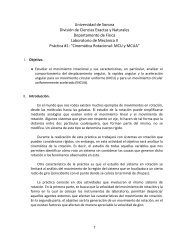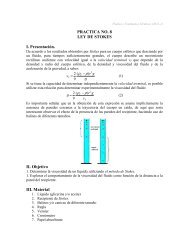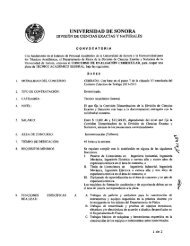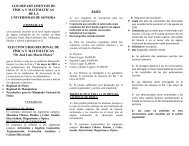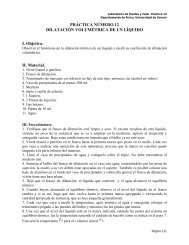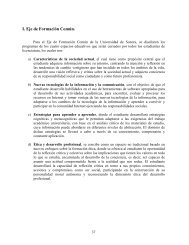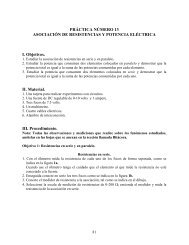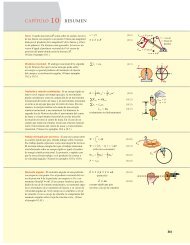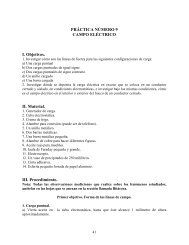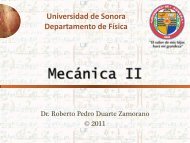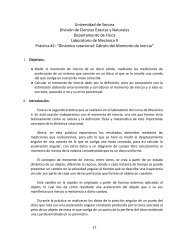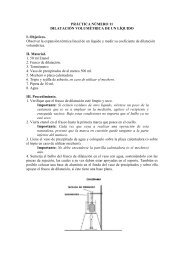Ley de enfriamiento de las sustancias
Ley de enfriamiento de las sustancias
Ley de enfriamiento de las sustancias
Create successful ePaper yourself
Turn your PDF publications into a flip-book with our unique Google optimized e-Paper software.
4. Enseguida, mida la temperatura inicial <strong>de</strong>l agua T 0 y simultáneamente ponga a funcionar el<br />
cronómetro. Esa será la temperatura inicial <strong>de</strong>l agua para el tiempo t = 0.<br />
5. Deje correr el cronómetro y mida el tiempo t que tarda la sustancia en bajar a 69, 68, 65, 60,<br />
55, 50, 45, 40 y 35 grados Celsius. No es estrictamente necesario que la medición se lleve a<br />
cabo <strong>de</strong> cinco en cinco grados. A cada tiempo t anote la temperatura correspondiente T(t).<br />
Importante: No <strong>de</strong>tenga en ningún momento el cronómetro.<br />
6. La última medición realícela cuando la temperatura <strong>de</strong>l agua no tenga cambios con respecto a<br />
la lectura anterior.<br />
V. Activida<strong>de</strong>s a realizar<br />
1. En el laboratorio el maestro colocará un termómetro en el centro <strong>de</strong>l mismo para que pueda<br />
ser consultado por los integrantes <strong>de</strong>l equipo para medir la temperatura ambiente, anote la<br />
temperatura. Es importante estar verificando permanentemente la temperatura ambiente y<br />
anotar cualquier cambio que ocurra para utilizarlo en el experimento.<br />
2. Llene la siguiente tabla con los valores <strong>de</strong> tiempo, temperatura <strong>de</strong>l agua y diferencia <strong>de</strong><br />
temperatura y usando la ecuación (1) <strong>de</strong>termine el valor <strong>de</strong> k en cada renglón.<br />
MEDICIÓN<br />
t T(t) ∆T= T(t)-T A<br />
minutos °C<br />
°C<br />
1 0 ∆T 0 =<br />
2<br />
3<br />
4<br />
5<br />
6<br />
.<br />
.<br />
.<br />
N<br />
Ln(∆T)= Ln(T(t)-T A )<br />
Ln(°C)<br />
K<br />
3. Grafique:<br />
a) La diferencia <strong>de</strong> temperatura contra el tiempo.<br />
b) El logaritmo <strong>de</strong> la diferencia <strong>de</strong> temperatura contra el tiempo.<br />
V. Consultas y preguntas<br />
1. Consultar notas sobre teoría <strong>de</strong> errores en:<br />
http://www.tochtli.fisica.uson.mx/fluidos y calor/errores.html<br />
2. Consulte en Internet el sitio http://paidoteca.dgsca.unam.mx/neopaidoteca/acervos/areaexp/Practicas/prinlenfnew.html<br />
en el cual se realiza un experimento <strong>de</strong> la <strong>Ley</strong> <strong>de</strong> <strong>enfriamiento</strong> usando<br />
otro equipo, se muestra también un vi<strong>de</strong>o.<br />
3. ¿Qué pasa con los intervalos <strong>de</strong> tiempo conforme la sustancia se aproxima a la temperatura<br />
ambiental?<br />
4. ¿Cómo explica el comportamiento anterior?<br />
46



